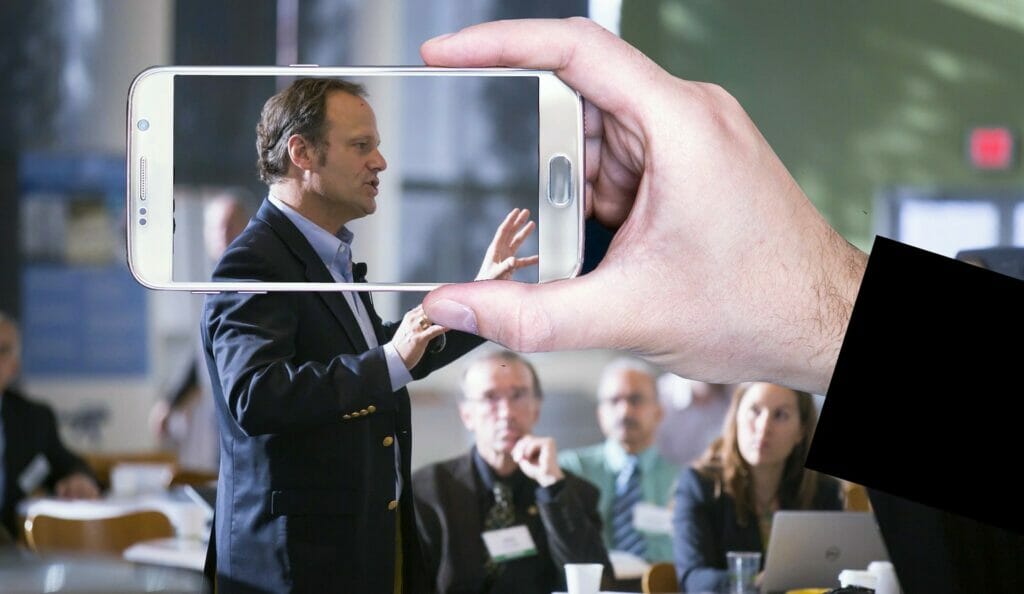
Virtual Presentations: How to Be a Success!
Virtual presentations are fast becoming a staple, for many reasons: international business cooperation, faster processes or circumstances such as the global Covid-19 pandemic. Today’s globalized business world operates internationally and in real-time.
It’s a new, fresh way of presenting, and one with endless possibilities. Once you’ve mastered the initial technical hurdles (and we’re here to help you with that), you can use it to great advantage. Read on for pointers on how to make the most of it and learn how PowerPoint can really help.
So, what’s the difference between a virtual and an in-person presentation?

Whatever you’re wanting to communicate, presentations (both online and in person) have three important components: the presenter, the audience, and the venue. How these components interact, however, changes depending on whether everyone involved is physically present in the same location, or all connecting from home. We set out below what you need to think about:
Online vs. in-person: Facilities during the presentation
In a classic presentation situation, you as the speaker usually know in advance exactly where your presentation will take place. Ideally, you already know the size of the premises, the number of seats and what technology will be available on site. This allows you to prepare yourself and your presentation for the situation.
A virtual presentation, whether from your home or the office, is somewhat different. You, as the speaker, will often be alone in the room. So, the size of that room is almost irrelevant – as is the number of seats. It’s more about a stable internet connection and whether or not you can see your audience.
You also need to know in advance how you can share your presentation slides with your audience via their screens. Whereas headsets offer freedom of movement at face-to-face events, they are usually not needed when giving a virtual presentation. What is new, however, is the camera: make sure you position yourself close to the center of the camera frame. In addition, you need make sure you have proper lighting. We’ll give you more tips on the technology below.
Online vs. in-person: Interacting with the audience
The audience also takes on a new role in the virtual presentation. Simply raising a hand to ask a question often doesn’t work online. It’s also difficult for the presenter to gauge audience reactions or integrate feedback. This makes it all the more important for a virtual presentation to run as smoothly as possible.
The goal should be catching the audience’s attention with well-presented topics within a coherent storyline.
Speech breaks, which are usually an opportunity for questions, applause or criticism, have to be replaced by clever transitions on your part during a virtual presentation. This means even more thorough preparation than usual.
The focus on the speaker is also greater in a digital presentation than in conventional presentations: the audience is forced to pay more attention to body language and voice.
Online vs. in-person: The presenter
The way a virtual presentation works resembles a video on your viewers’ screens. This means that there are clear visual boundaries: everything within these boundaries is visible to the audience and everything outside is not only irrelevant to the presentation, but deliberately impossible to see.
This can be an advantage: in a classic in-person presentation situation, with a large venue and a big audience, people can be distracted from what you’re saying due to outside factors. In a virtual presentation, there are no such external influences – the focus is solely on you and the content you present.
You need to decide in advance where exactly you are going to give your presentation, taking into account your surroundings and how you look in front of them. In terms of your background, the golden rule here is “less is more”. While you don’t need a bare white wall behind you, cluttered backgrounds really distract your audience from what you’re trying to say.
You are the focus of the presentation, so try to avoid distractions such as crowded shelves, documents lying around or others walking past. You can help by choosing the right clothing; if the background is light, you should dress in dark clothes, and vice versa. Try to keep it as classic as possible: loud patterns or colors will distract from what you’re saying. First and foremost, however, dress to make yourself feel professional: if you feel uncomfortable, it always comes across to the audience.
Summary:
The biggest differences between in-person and virtual presentations:
- Content in virtual presentations is more in focus
- Interaction with the audience is significantly reduced
- Body language, and especially the voice, are more important
- The preparation required is very different

Preparing your virtual presentation
This section provides a number of tips for preparing your virtual presentation, in the form of a checklist. This is not about creating the actual PowerPoint presentation, but a guide to maximizing the other factors that influence your audience. (Our step-by-step guide to how to create an excellent online PowerPoint presentation can be found here.
Minimize possible external interference
Have you turned your cell phone to silent? Always the first point in the rule book! You risk coming across as unprofessional if your own phone rings during your presentation. With a simple click, you can mute your phone and avoid this.
If you’re not alone in the room you’ll be presenting from, let your colleagues or roommates know beforehand that you need quiet during your virtual presentation.
Technical requirements
To present well online, you’re going to need a microphone and a camera or webcam. You need to test these thoroughly before the event. Technical problems can lose you your audience and throw you off track unnecessarily. You can avoid this by following our detailed tips below.
The PowerPoint presentation
When giving a virtual presentation, it’s even more important than usual to make sure your slides are easy to read and sensibly structured. It’s often enough to put down just the key points – you can elaborate on them verbally. Less is more. You can always provide background information as a digital handout.
Presenting yourself
We covered how your choice of clothing should be considered above, and how it should relate to your background. In terms of the latter, a current trend is to use digitally generated backgrounds that show the speaker on Caribbean beaches or in outer space. These really have no place in serious business presentations.
If you use a digital background, the golden rule of high contrast applies: make sure you stand out as distinctly as possible from your actual background, so the software can differentiate you from your background. Otherwise, odd bits of you may flicker in and out of view – needlessly distracting.
Where you present from
Make sure that the room where you will be giving your talk is as quiet as possible. Close the windows if there is a lot of traffic, turn down devices that are not needed before the presentation, and give any other people in the room plenty of notice.
As noted above, your background should be as uncluttered as possible. You also need to always feel comfortable during the presentation – a decent seat and optimum room temperature help.
On your desk
Keep the desk where you sit during your presentation as clear as possible. Unnecessary objects can be distracting. You only need the documents relevant to your presentation in front of you. You might also consider a glass of water and tissues, to help with dry mouth or a runny nose, but these can be put out of view until needed.

Presenting virtually: our pointers
Basic tips for the virtual presentation itself
A structured presentation follows a well-thought-out arc. This serves as a common thread which links the core messages and values of your presentation. It pays to consider the following in advance:
What are you aiming to achieve with your presentation? Who is your target audience? What information is absolutely necessary, and what isn’t? How do you fit all the information into a meaningful sequence, and how do you fit it into the given time frame?
All the content of the presentation should serve your core message and intention. Anything that doesn’t support your message should be left out (you can put it in your digital handout if needs be). Always keep your audience in mind. Who is listening to you and what do you want your virtual presentation to accomplish for them? The focus of your presentation should always be on what your audience will get out of it.
Formulating a clear core message is particularly important in virtual presentations. As many participants are alone at home and often unseen, their attention can wander more quickly than at face-to-face events. This makes it all the more important to formulate a clear call-to-action and to emphasize it repeatedly. At the end of your presentation, the audience should know what they have to do now.
The right body language

Compared to a face-to-face presentation, virtual presentations paradoxically bring you much closer to the audience. The facial expressions and gestures of the presenter are much more up front and personal on a home screen than seen from the back row of a packed auditorium. Being aware of your face and general body language is very important.
A calm, relaxed posture and appearing friendly and attentive are essential. You may find it helps to stand; an upright posture conveys a feeling of confidence, even to yourself. Unsettled body language not only makes your audience nervous but can also create real inner turmoil in a presenter.
This transmits very quickly to the audience. Also, depending on the quality of the camera and your internet connection, fast movements or gestures can lead to jerky transmissions.
Calm movements also help with nerves and ensure a smooth speaking voice. Another important aspect for presentations in general is eye contact; this not only helps you build connections with your audience but holds their attention. Establishing on-camera eye contact without visual feedback can seem strange at first.
Practice looking into the lens of your webcam every now and then, creating a sense of connection online. We really recommend filming your presentation on a trial basis and checking how you come across.
We’ve put together some great tips on body language during presentations here.
Virtual presentations: Your voice is your most important asset
To keep your audience’s attention, you need to tell an interesting story with your presentation. This works so much better when you get your voice pitch and intonation right. Monotonous presentations quickly send your audience to sleep and fail to do justice to their content.
So, learn to use your voice to help rather than hinder: a lively voice, with a well-adjusted speaking tempo, using pauses deliberately for effect, help your audience to warm to you and pay attention to your message. Slow, clear speech is of the utmost importance, especially for virtual presentations. We’ve collected loads more useful tips for you here.
Involve the audience
It’s particularly difficult to maintain and sustain an audience’s attention when presenting online. Distractions on the home computer are many and most are only a mouse click away. So, try to involve your audience in the presentation right from the start. Lively dialogue keeps people attentive and produces great results.
Encourage your audience to ask questions in the chat or participate in quick online polls. As your virtual presentation progresses, you can address this new input or answer queries. Active audience participation increases attention and generates a sense of inclusion, making your audience more likely to buy in to your message.
If you want to be able to address any questions that come up without interrupting your flow of speech and thought, it’s best to get help from moderators. Someone else in your team can keep an eye on the live chat during the virtual presentation, for example, or screen questions from the audience and include them in the presentation at the appropriate point.
If you don’t have anyone who can do this, you could work through all the questions with the audience at the end of the presentation, so you don’t run the risk of being thrown off track whilst giving the presentation. Whichever way, you should try to actively interact with your audience, and give them clear instructions so they know what to expect.
Extra tip: Use interactive tools

There are now many online tools you can use to make the interaction with your audience more varied during virtual presentations. here are a few of the best, with short summaries of their most useful applications.
| Slido: | Offers live questions from the audience as well as votes and polls. |
| SlideLizard: | Suitable for presentations, meetings, workshops or seminars. As a subsidiary tool of PowerPoint, SlideLizard can be integrated into your PowerPoint presentation without having to open another application in parallel. |
| Tedme: | Specializes in conferences, lectures and seminars. It offers interactive question and answer sections, polls, voting and quiz games to engage the audience. |
| Mentimeter: | Focuses on presentations and workshops and functions as a web-based service with simple log-in code. |
| Glisser: | For events and workshops. Interactive slides, polls and a social wall allow effective audience interaction. |
| td:wrk: | An online voting tool giving you the possibility to use and integrate results of votes live. |
| VoxVote: | Free, and available in various languages. Results can be displayed and embedded directly in your presentation slides. |
| OMBEA: | This tool works closely with Microsoft, so all the results can be displayed in real time on your PowerPoint slide. |
| VoxR: | Provides polls with real-time results and additional information about your presentation for the audience. During your virtual presentation, all participants can click on information that you have posted in advance – such as an agenda, maps, or additional information about the event. |
| feedbackr: | Surveys in real time. |
| OnlineTED: | Focuses on voting in universities and other educational institutions. Free and web based. |
| POLYAS: | Ballots, polls and other online live voting. Suitable for analyzing results, rather than for use during a live presentation. High security factor. |
| Backchannel: | Offers several web-based survey options. |
| Wooclap: | Focuses on students. Can be used for remote learning and encourages interaction among all participants. |
| Socrative: | Focuses on high school and college students. Supports online lectures by educators. Offers surveys, interactive quizzes, tests, games and more. |
| eduVote: | Popular in universities and other colleges. Offers some survey options. |
| AhaSlides: | Can be used in the business world as well as the classroom. Includes polls, question-and-answer sections, and other interactive features. |
| Kahoot: | A game-based learning platform with a focus on schools, universities and companies. Allows content to be queried in a playful manner and new topics initiated in an interesting way. |
Presenting virtually: Keep it interesting!
Nowadays, it’s common practice to communicate in pictures: emojis and GIFs in texts, traffic signs, or cartoons in newspapers. These are often more immediate than a long-winded description. Even in business presentations, using visual media in a sensible way can not only help to dynamically present content, it also grabs the attention of your audience. Mixing up different forms of media within your presentation can keep your audience on their toes. It’s definitely not something to overdo, though: using too many visuals can obscure your serious content. Keep it simple: any use of visual media needs to serve a specific purpose. They should underpin your content and not distract from it.
For more tips on using and designing visual media, check out our blog:
Optimize Images in Your Presentations
Insert Videos into PowerPoint: Tutorial & 4 Creative Tips
PowerPoint Animations: Create Accents in Your Presentation
Technical Tips for your virtual presentation

When presenting online, you have to pay more attention to how your presentation is delivered technically than when speaking in person. Your audience needs to be able to concentrate solely on your content and not be distracted by avoidable technical problems. Solid, basic equipment is essential for this.
A good microphone is essential in order to be clearly heard and understood. But what sort? You’re really best off avoiding any kind of laptop, tablet or smartphone internal microphones. They tend to sound either too quiet or too boomy, and ambient noise can lead to interference.
You’ll need a headset or, even better, an external microphone. External microphones can be free-standing table microphones normally used for podcasts or on the radio, or small clip-on microphones that give you unrestricted mobility during your presentation. The shorter the distance between the microphone and your mouth, the lower the risk of distracting ambient noise.
While giving your virtual presentation, try to maintain a constant distance to avoid too many fluctuations in volume. The easiest way to do this is with a lapel microphone. Always test the sound quality before your presentation by making a test call to a colleague.

To make sure that your audience can see you clearly, you need to pay attention to the camera you use and how you position it. Nowadays, there are many inexpensive, high-quality webcams around. There are also exciting apps that can turn your smartphone into a webcam if needed. Audiences now expect virtual presentations to be in HD resolution.
Even more important than the resolution of the camera, though, is how you position yourself within the image frame. You want to be the focus of the presentation but face your audience at eye level. So, position the camera lens at your eye level. You should be as close to the center of the frame as possible, while also making sure the camera is vertical. If the camera (and therefore your audience) is looking down on you, you may appear smaller or “lost” – if looking up at you, you can appear overbearing.
Another thing to consider is appropriate lighting. Avoid rooms with dim lighting and low contrast. Your face needs to be fully illuminated. Pay attention to the intensity and warmth of the light source. Ordinary lamps can give off light that is too warm, appearing yellowish, while office buildings often have only harsh halogen lights. Simple photo and ring lights are now widely available.
Dimmable lights help you to properly regulate the intensity of your light source, meaning you avoid being over or under lit. Point your light at approximately eye level, similar to the camera. This avoids casting any unwanted shadows on your face. For an even more professional impression, we recommend a second light source directed slightly from the side. This minimizes any residual risk of unflattering shadows on your face.
Tip for those who wear glasses: Take care to avoid glaring reflections in your glasses. It helps to use large-area indirect lighting, rather than directly lighting your face. Try finding a bright room with large reflective surfaces – for instance, white walls.
Stand out with the best virtual presentation!
The points we’ve covered above offer a detailed introduction to the topic of digital presenting. We’ve looked at the differences between virtual presentations and traditional, in-person events, dividing them into three key factors: the location of the presentation, the speaker, and the way in which the speaker interacts with the audience.
When presenting today, it is essential to be flexible. Presentations have to be moved from a large conference room to your home at the drop of a hat. If you follow our tried-and-tested advice, you’ll never break a sweat. We’ve covered technical advice on setting up your space, your backdrop, your equipment, and yourself. With the right lighting, the right microphone, and a motivating, multimedia interaction with your audience, nothing will stand in the way of the success of your next virtual presentation.
If you would like advice tailored to you personally, please don’t hesitate to contact us! We are happy to help you with anything regarding PowerPoint. Contact us at [email protected]. We look forward to hearing from you!




